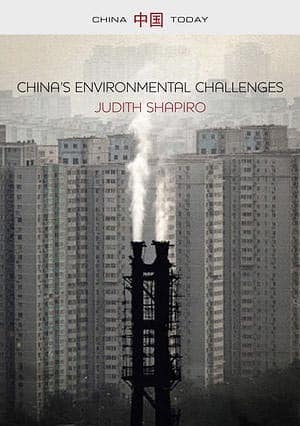It’s well-known that China faces severe pollution problems, but there is a dearth of concrete information in English about the nature, extent, and causes of the country’s environmental crises. Judith Shapiro’s book, China’s Environmental Challenges, published this month by Polity Books, will help fill the information gap.
Shapiro, who has lived and taught in China, now teaches environmental politics at American University. Her previous books include Mao’s War against Nature (Cambridge University Press 2001).
C&C plans to review China’s Environmental Challenges in future, but now we’re pleased to publish this excerpt from its first chapter. The entire chapter, including source references, is available in PDF on the author’s website. To aid onscreen readability, we have added some paragraph breaks.
UPDATE: review of China’s Environmental Challenges
Copyright © 2012. Published with permission from the publisher, Polity Books.
by Judith Shapiro
The World Bank has found that 20 of the world’s 30 most polluted cities are in China, primarily because of heavy coal use, with Shanxi Province’s coal mining city Linfen the dirtiest.
China’s high economic growth rate — close to 10 percent per year between 2000 and 2011 — must be greatly discounted with the inclusion of environmental costs in lost work days, premature deaths, and pollution clean-up. In 2004, for example, economic losses caused by environmental pollution accounted for as much as 3 percent of GDP. Additional costs resulting from resources depletion and ecological damage could not be calculated due to lack of data.
Efforts by some government officials and think tank scholars to create a reliable “Green Gross Domestic Product” calculation for China stalled from 2004 onwards, in part because of the political sensitivity of the effort and the difficulty of obtaining reliable statistics.
Air pollution is a huge challenge. The problem was made famous by the attention to poor air quality in the capital during the lead-up to the 2008 Beijing Olympics, but it is even more serious in other parts of the country.
The World Resources Institute found that total suspended particulates (TSP) and SO2, both produced by burning coal, far exceed World Health Organization guidelines in the majority of Chinese cities.
Lung diseases such as tuberculosis and cancer are so prevalent that Chinese “cancer villages,” in which cancer death rates due to air and water pollution are far above the national average, are well documented. By 2010, the media and Internet had drawn attention to 459 cancer villages distributed across 29 of China’s 31 provinces.
Meanwhile, severe water pollution affects 75 percent of China’s rivers and lakes and 90 percent of urban groundwater, with 28 percent of China’s rivers ranked category five (the worst) on a Chinese scale of one to five, so toxic that they are unsuitable even for agricultural use.China’s major lakes such as Lake Taiin Eastern China and Dianchi in Yunnanare ranked at category five.
A 2007 OECD study found that hundreds of millions of Chinese people drink water contaminated by arsenic, fluoride, untreated wastewater, fertilizers and pesticides.
In addition to pollution problems, groundwater aquifers are rapidly being depleted as users dig deeper wells each year. Falling water tables in North China threaten the water supply of Beijing. The great Yellow River does not reliably flow all the way to the sea; in 1997, the worst year so far, it failed to reach the eastern delta for 226 days, essentially drying out.
In a book originally published in Chinese in 1999, water pollution activist Ma Jun states that 400 out of 600 cities faced water shortages, including 30 out of the 32 largest cities. Attempting to deal with this threat, the Chinese government is building a three-channel “South-North Water Transfer Project” to move water from the Yangzi to the Yellow River, a multibillion dollar megaproject with enormous environmental and social implications, including effects on irrigation in the South where farmers accustomed to access will be deprived, human rights implications for the forcibly relocated, and devastating ecological impacts on the Tibetan Plateau should the Westernmost channel be built.
Research studies have suggested that water stress could create massive numbers of dislocated “environmental refugees” in coming decades as large parts of China face water shortages. The World Bank has estimated that more than 300 million people in rural China lack access to safe drinking water.
Water shortages, sea-level rise, increased droughts, and disruptions of rainfall patterns from climate change could cause the displacement of millions of Chinese by 2050.China’s rainfall is already highly seasonal — with 70 percent falling during the rainy months and 30 percent during the dry — and geographically uneven.
The North, with 60 percent of China’s cropland, has only 16 percent of its water, while the South, with 40 percent of the cropland, has 84 percent.
When climate change, pollution, and overuse for irrigation and industry are added to this fundamentally insecure situation, the Chinese people’s access to water becomes highly unpredictable.
Given the severity of these and other entrenched problems such as deforestation, erosion, desertification, heavy metal pollution, salinization, loss of arable land, acid rain, and biodiversity loss, China’s handling of its environmental crisis has become of critical importance to the country’s stability and the legitimacy of the government.
Indeed, the nation’s environmental challenges are so severe and so central to the manner in which China will “rise” that it is no exaggeration to say that they cannot be separated from its national identity and the government’s ability to provide for the Chinese people.
Acute environmental degradation threatens social stability; increasingly, environmental protests trigger state concerns about broader unrest. “Environmental mass incidents” sparked by local pollution are estimated to number 5,000 per year, with some reports putting the figure much higher. Many of these involve only a small crowd or short protest and are resolved in a matter of hours, while others involve thousands of people and shut down major cities.
The Chinese Communist Party and the state government’s controls of power are at stake as they try to achieve contradictory aims.
They must provide an improvement in material living standards in a country whose hinterlands are still desperately poor and whose middle class is just beginning to discover the joys of consumption after decades of privation.
At the same time, they must deal with industrial accidents, the environmental costs of the country’s manufacturing so many of the world’s consumer products, and growing resistance to toxic pollution.
Despite being armed with some of the world’s best environmental laws and regulations,China’s bureaucracy faces huge challenges in implementation. Local incentives to cut corners on regulatory implementation and enforcement and pursue polluting practices prevail.
While some government officials and agencies are making serious attempts to shift the country to an alternative development model, these efforts often seem puny when pitted against powerful forces of corruption, decentralized authority structures beyond the reach of the law, and incentives to focus on economic growth to the exclusion of other considerations.
China’s civil society is still weak and mistrusted by central powers, so efforts to deal with severe environmental problems “from the bottom” through public pressure are also inadequate in the face of monumental problems. When, moreover, one considers that there are cultural factors that emphasize conspicuous consumption and mistrust of government authority, and even rationalize illegal behavior in the interest of financial gain, the challenges can seem very great indeed.
As Jonathan Watts writes in When a Billion Chinese Jump, “China’s political system now exhibits the worst elements of dictatorship and democracy: power lies neither at the top nor the bottom, but within a middle class of developers, polluters, and local officials who are difficult to regulate, monitor, and challenge.”
China’s environmental challenges are thus tied to domestic political structures, rapid economic growth, and an intense phase of globalization in which the entire planet is involved. We can productively use the lens of development studies to understand these dynamics, since China has so rapidly moved from being a less developed country to a transitional one to one that is already a superpower. The key question is whether this unprecedented development will be “sustainable.”





Unless China gets its ecological act together its development, as is true for any country, is unsustainable. We humans might think and behave as though we are outside of nature but we are not we are inextricably part of the biosphere and subject to its laws.